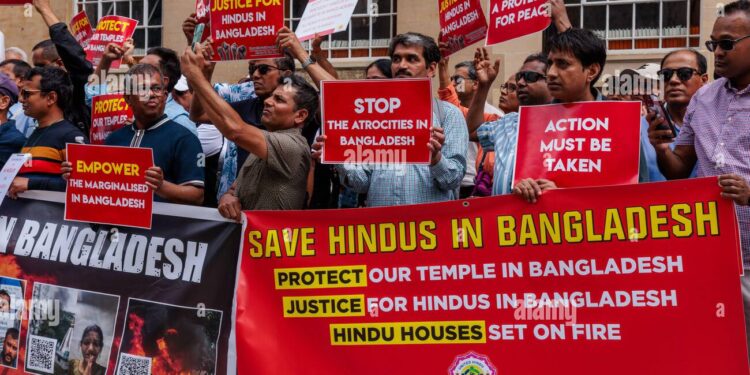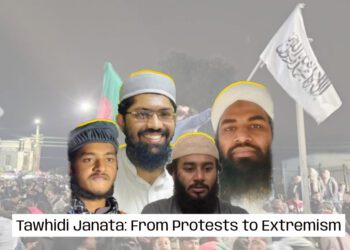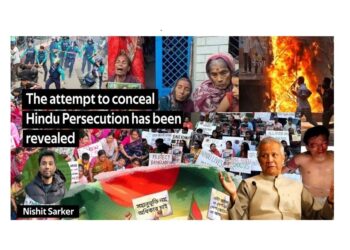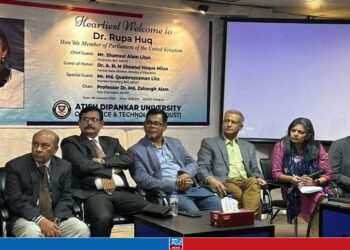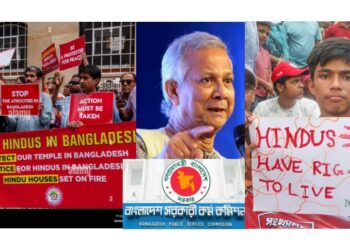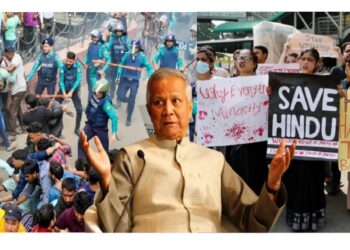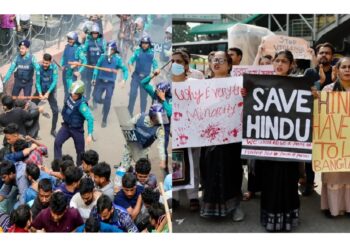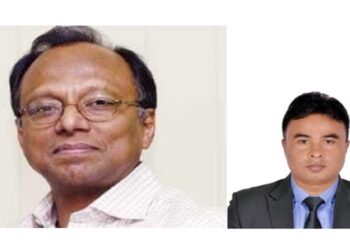- The attack on the ISKCON temple ecosystem in Bangladesh reflects a broader conspiracy to undermine Hindu temples and weaken Hindu culture and civilization.
- The UN remains silent despite many global leaders condemning the persecution of Hindus in Bangladesh.
- The international community offers no official condemnation or acknowledgment of Hinduphobia, even as Hindus face violent attacks and their places of worship are destroyed.
- Western media downplays Hindu persecution in Bangladesh, framing it as an “India-Bangladesh conflict.”
- The situation in Bangladesh should alert the Indian government to demographic shifts threatening the safety and liberty of its Hindu population.
There have been over 2,000 reported attacks on Hindus in Bangladesh since former Prime Minister Sheikh Hasina fled the country on August 5.[1] [2] This figure likely represents only a fraction of the reality, as hundreds of videos circulating on social media show disturbing footage of assaults on Hindus and their properties. Indian media, particularly the Republic Network, has been extensively covering the deteriorating situation, with Republic Bangla reportedly maintaining direct sources in Bangladesh to provide ground reports.
Despite the alarming reports, the unelected caretaker government, led by Mohammad Yunus, dismisses the attacks as “baseless propaganda originating from India.”[3] This aligns with Bangladesh’s official narrative, portraying the media coverage as politically driven rather than acknowledging its communal undertones.[4]
Meanwhile, the anti-Hindu violence has escalated with a new tactic: targeting religious and spiritual leaders. Recently, ISKCON priest Chinmoy Krishna Das was arrested for allegedly disrespecting the Bangladeshi national flag by hoisting a saffron flag above it. Reports suggest his lawyer, Regan Acharya, was brutally assaulted, and his office vandalized, leaving the priest without legal representation.[5]
The Yunus regime’s blatant attempts to whitewash and downplay the ongoing anti-Hindu violence exemplify “discursive Hindudvesha,” where the narrative minimizes actual acts of violence and silences dissenting voices. By labeling credible reports of atrocities as propaganda, the regime is complicit in perpetuating an atmosphere of fear and denial.
What is unfolding in Bangladesh is part of a larger pattern of global Hinduphobia, or Hindudvesha. This operates on two levels: first, through direct acts of violence, intimidation, and fearmongering targeting Hindus and their places of worship, and second, through the construction of counter-narratives in media and academia. These narratives emphasize “Hindu majoritarianism” and “Hindutva supremacy,” effectively discrediting Hindu suffering and masking anti-Hindu hatred and violence. This dual strategy not only exacerbates the plight of Hindus in Bangladesh but also undermines efforts to address systemic oppression and ensure justice.
Attack on the Hindu Institutions
The arrest of ISKCON priest Chinmoy Krishna Das by Bangladeshi authorities is not an isolated incident. Numerous media reports indicate that ISKCON priests in Bangladesh have been arbitrarily detained.[6] Additionally, Bangladesh’s immigration police recently denied entry to 54 ISKCON members attempting to cross into India.[7] The situation has deteriorated to the extent that ISKCON India has advised its monks and devotees in Bangladesh to avoid wearing “malas” and “tilaks” and to practice their faith discreetly.[8]
The Yunus regime has further exacerbated the situation by propagating a narrative that brands ISKCON as a terrorist organization. Groups like Hefazat-e-Islam have fueled this anti-ISKCON propaganda, portraying the Hindu spiritual organization as a radical entity that should be banned.[9] Although the Bangladesh High Court has rejected calls to outlaw ISKCON, the government has officially labeled it a “religious fundamentalist organization,” and demands for its prohibition are growing louder.
This targeted campaign against ISKCON is part of a broader, orchestrated effort to dismantle the Hindu temple ecosystem globally. Attacks on Hindu temples in Western nations such as the US, UK, and Canada, combined with the targeting of ISKCON in Bangladesh and the secularization of temples by Communist-led governments in Indian states like Kerala and Tamil Nadu, point to an interconnected strategy.
The attacks on temples are designed to shrink the spaces where Hindus can congregate and express collective concerns. The underlying message is clear: Hindu temples should restrict their activities to worship and rituals, avoiding any role as a unifying voice for the Hindu community. Globally, Hindu temples are among the last bastions of non-Abrahamic civilizations, which makes them prime targets for those seeking to erode Hindu cultural and spiritual resilience.
In Bangladesh, where Islamic radicalism has surged post-Hasina, temple attacks threaten Hindu culture’s survival. Temples provide spiritual solace, foster community cohesion, and resist cultural erasure, serving as Hinduism’s last stronghold amid increasing secularization. These sustained attacks on the Hindu temple ecosystem represent a deliberate strategy to dismantle these cultural and spiritual bastions. If temples are silenced and dismantled, the forces of conversion and cultural erosion will face little resistance. This systemic targeting of temples—whether in Bangladesh or elsewhere—appears to be aimed at weakening Hinduism’s institutional and communal framework, making it more vulnerable to external pressures and internal disintegration.
ISKCON Crackdown and Tulsi Gabbard’s Nomination: A Deep State Conspiracy?
A potential angle to the Bangladeshi government’s anti-ISKCON campaign may involve US politics. Tulsi Gabbard, US President-elect Donald Trump’s nominee for Director of Intelligence, is a practicing Hindu and a follower of ISKCON. This has fueled speculation that the sudden targeting of ISKCON in Bangladesh under the Yunus regime could be part of a broader conspiracy by the “deep state” to obstruct Gabbard’s nomination. While these theories remain speculative, the timing of ISKCON’s persecution in Bangladesh raises questions. The crackdown aligns with Gabbard’s nomination announcement and follows a series of personal attacks against her for her “Hindu” identity.
A recent opinion piece in the Financial Times referred to Gabbard as a “devotee of an obscure religious cult.” While the article is accessible only to subscribers, screenshots shared widely on social media have sparked backlash, with many accusing the publication of blatant Hinduphobia.
Prominent Indian author Ashwin Sanghi criticized the Financial Times in a post on X:
Shameful @FT! Tulsi Gabbard is a “devotee of an obscure religious cult”? Hinduism has 1.2 billion followers and is the world’s oldest faith. And the International Society for Krishna Consciousness (ISKCON) – or the Hare Krishna movement – has millions of members![10]
Other media outlets have also reported that Gabbard’s alleged ties to a “cult” with a supposed “history of antagonism towards LGBTQ people and women” could complicate her Senate confirmation.[11] [12] These narratives, combined with the anti-ISKCON sentiment in Bangladesh, suggest a coordinated effort to undermine Gabbard’s credibility. Gabbard, as a prominent Hindu leader in US politics and a known ISKCON devotee, appears to be facing targeted demonization based on her Hindu identity.
This is not the first time Gabbard has been in the cross-hair for her Hindu heritage. Far-left publications have repeatedly accused her of connections to Hindu nationalist organizations. A 2019 article in The Caravan claimed that Gabbard’s political rise was financed by donations from “Indian American Sanghis,” members of organizations linked to the Sangh Parivar, such as the RSS. The piece portrayed Gabbard as being “groomed” by the so-called “American Sangh,” framing her Hindu identity as a point of suspicion.[13]
The coordinated narratives promoted by these media outlets reveal a disturbing pattern of Hinduphobia, targeting both Tulsi Gabbard for her Hindu faith and ISKCON for alleged radicalism. The Bangladeshi government accuses ISKCON of extremism, while similar accusations are directed at Gabbard in the U.S., both part of a broader effort to discredit Hindu institutions globally.
Muted Global Reactions
While individual political leaders worldwide have expressed concern, official condemnation from Western countries remains conspicuously absent. Most glaring is the silence from the United Nations, which has yet to formally address what some are describing as a genocide against Hindus in Bangladesh. Despite promises of action, tangible interventions from the global community have been limited.
The New Delhi-based Rights and Risks Analysis Group (RRAG) recently urged British Minister Catherine West to address the issue. Despite her promise to facilitate UN intervention, the United Nations has yet to act, highlighting global inaction.[14]
The UK has seen more vocal reactions compared to other nations. British MPs Priti Patel, Barry Gardiner, and Bob Blackman have raised concerns in the UK Parliament. Patel described the events in Bangladesh as “deeply, deeply concerning.” Gardiner, representing a constituency with a significant Hindu population, warned that the situation was precarious and “on a knife edge.” Blackman went further, labeling the events as an attempt at the ethnic cleansing of Hindus and accusing the Bangladeshi regime of deliberate religious persecution.[15] [16]
In the US, Vedant Patel, Deputy Spokesperson for the US State Department, urged Bangladesh to uphold fundamental freedoms, including religious rights. Johnnie Moore, a former Commissioner of the United States Commission on International Religious Freedom (USCIRF), also highlighted the persecution of Hindus in Bangladesh, emphasizing the global silence surrounding their plight.[17]
India’s Ministry of External Affairs has issued a formal statement expressing concern over “extremist rhetoric, increasing incidents of violence, and provocation” in Bangladesh. The Indian government has reportedly raised the issue of attacks on Hindus and other minorities multiple times with its Bangladeshi counterparts.[18]
Despite these statements, much of the international response remains steeped in diplomatic language. Given the Yunus regime’s blatant disregard for human rights, calls for cooperation appear futile.
Another glaring issue is the reluctance to address the communal nature of the violence. Most international condemnations frame the situation as a generic “human rights violation,” ignoring the explicit anti-Hindu bias at its core. This failure to confront Hinduphobia reduces the scope for a meaningful discussion on the underlying hatred fueling the crisis.
Among the voices of concern, British MP Bob Blackman stands out for explicitly naming Hinduphobia as a driving force behind the violence. In contrast, most global reactions avoid emphasizing the communal aspect of the attacks. Even in the UK, condemnation has largely come from MPs representing Hindu-majority constituencies, reflecting a localized rather than widespread concern.
The absence of broader civil society outrage is striking. International celebrities, media outlets, and organizations often leading global advocacy campaigns have largely remained silent, highlighting a troubling pattern: Hindu issues rarely receive the same level of international attention or indignation as other human rights crises.
Media Apathy
Gaslighting Hindu issues is a hallmark of Hinduphobia, evident in Western media’s biased coverage of the crisis in Bangladesh. Since Prime Minister Sheikh Hasina’s resignation and departure to India, persecution of Bangladesh’s Hindu minority has intensified. Yet, Western media largely ignores or distorts the issue, framing it through misleading geopolitical narratives. Many outlets fail to report the violence, while others downplay it or reframe it as a facet of India-Bangladesh relations.
There seems to be a collective and deliberate strategy attempt by the media to reduce this grave human rights crisis to a bilateral political dispute and undermine its true severity. For instance, a recent BBC headline read, “India-Bangladesh tensions soar amid protests.”[19] The introductory lines of the report emphasized a “war of words” between India and Bangladesh, overshadowing the plight of persecuted Hindus. The article exaggerated the “violent” nature of protests in India’s Tripura state while completely ignoring the context: the systemic attacks on Hindus in Bangladesh, thus trivializing the violence against Hindus and shifting the focus away from the real issue.
Similarly, The New York Times published a piece titled “Two South Asian Neighbors, Once Friendly, Are Now at Bitter Odds.”[20] The article placed undue emphasis on India’s ruling BJP and its perceived “Hindu” agenda, portraying reports of anti-Hindu violence in Bangladesh as disinformation spread by “right-wing” media. The piece downplayed the scale of the violence, suggesting that terms like “genocide” were overused and stating that Hindu leaders in Bangladesh claimed only a “few” deaths in their community.
Another example is a headline from The Washington Post: “Bangladesh court defers Hindu leader’s bail hearing as tensions with India spike.”[21] The article, accessible only to subscribers, followed the usual pattern of framing the crisis through the lens of India-Bangladesh relations. It echoed the official narrative of the current Bangladeshi regime and avoided directly addressing the anti-Hindu violence, let alone condemning Hinduphobia.
The Guardian has also prioritized geopolitical angles over the human rights crisis. A headline reading “India-Bangladesh relations sour as tensions rise over attacks on Hindu minority”[22] focused more on the diplomatic fallout than the plight of Hindus. The accompanying blurb discredited reports of violence, labeling them as “allegations” and emphasizing the vandalization of a Bangladeshi consulate in India over the far more severe attacks on Hindu communities in Bangladesh.
A recurring theme in Western media is the narrative that India’s “Hindu majoritarian Modi government” is using the issue of Hindu persecution in Bangladesh to discredit the current regime. These reports often imply that India’s support for Sheikh Hasina is part of a plot to reverse the regime change in Bangladesh.
This selective focus reflects a broader pattern of bias. Instead of addressing attacks on Hindu temples, arrests of monks, and destruction of religious spaces, Western media often shifts attention to diplomatic disputes, portraying India as the aggressor. The persecution of Hindus in Bangladesh is rarely covered as a standalone issue, sidelining discussions on Hinduphobia or communal violence. Framing Hindu persecution as “Indian propaganda” downplays the crisis and perpetuates Hinduphobia, highlighting a broader reluctance to acknowledge or address the systemic oppression of Hindus on a global scale.
Lessons for India
The ongoing crisis in Bangladesh carries profound implications for India’s national security. It offers a glimpse into a possible dystopian future—one where Hindus are a shrinking minority in certain regions of the subcontinent.
Managing demographic shifts is crucial for India, as states like Jammu and Kashmir, West Bengal, Kerala, and Assam face challenges from rising Muslim populations. Assam, notably impacted by migration linked to Bangladesh’s unrest, has seen increased Muslim influx. Chief Minister Himanta Biswa Sarma has highlighted these concerns, announcing plans for a white paper next year to detail Assam’s demographic changes and their effects on the region’s Hindu population.[23]
West Bengal has also experienced alarming consequences of demographic shifts. The infiltration of Rohingya Muslim refugees has exacerbated tensions in the region, with Hindus increasingly vulnerable in areas where they are a minority. The chilling incidents of Sandeshkhali violence earlier in 2024 exemplify this.[24] Reports suggest these attacks were part of a larger pattern of “demographic jihad,” where Islamists seek to alter the demographics of a region through targeted violence against Hindus.
The Western media’s portrayal of these issues is starkly biased. While the plight of Rohingya Muslim refugees often garners global sympathy, the suffering of Hindu refugees from Pakistan, Afghanistan, and Bangladesh is met with indifference. India’s measures to address demographic challenges—such as the Citizenship Amendment Act (CAA), designed to grant citizenship to persecuted minorities from Islamic countries—are branded as “human rights violations” by the same Western media that ignores the systematic persecution of Hindus. Misinformation campaigns around the CAA have further complicated efforts to protect vulnerable Hindu communities.
India must view the situation in Bangladesh as a critical warning about the broader threat posed by demographic shifts. The violence and oppression faced by Hindus in Bangladesh today could manifest within India’s borders tomorrow if these trends remain unaddressed.
Wrapping Up
The persecution of Hindus in Bangladesh represents a grave human rights crisis that demands urgent global attention. This is not merely an “India-Bangladesh problem” but a broader issue of minority rights and religious freedom.
The systematic targeting of Hindus in Bangladesh is not a new phenomenon. Since the country’s independence in 1971—and even earlier during its time as East Pakistan—Hindus have faced relentless discrimination and violence. Official records from the 1951 East Bengal (East Pakistan) census show Hindus constituted 22% of the population. This figure dropped to 15% by 1991 and a mere 8.5% by the 2011 census. Such stark declines reveal the ongoing exodus and extermination of Hindus over decades.
It is long overdue for the international community, including the United Nations, to recognize and address the persecution of Hindus in Bangladesh. Concrete actions must be taken to condemn Hinduphobia and ensure the protection of vulnerable Hindu populations. Failure to do so risks emboldening forces of hatred and eroding the principles of human rights and religious freedom globally.
Citations
[1] WATCH | Yunus says attacks on Hindus in Bangladesh ‘baseless propaganda originating from India’ – Firstpost; https://www.firstpost.com/world/muhammad-yunus-calls-attacks-on-hindus-in-bangladesh-baseless-propaganda-originating-from-india-13836001.html
[2] ‘Over 2,000 attacks on Hindus since August 4’: Minorities hold massive rally in Bangladesh | Today News; https://www.livemint.com/news/over-2-000-attacks-on-hindus-since-august-4-minorities-hold-massive-rally-in-bangladesh-11730624516933.html
[3] WATCH | Yunus says attacks on Hindus in Bangladesh ‘baseless propaganda originating from India’ – Firstpost; https://www.firstpost.com/world/muhammad-yunus-calls-attacks-on-hindus-in-bangladesh-baseless-propaganda-originating-from-india-13836001.html
[4] Home adviser for revealing truth against Indian media’s propaganda (बस्स News); https://www.bssnews.net/news-flash/227824
[5] Bangladesh violence: No lawyer turns up for Iskcon priest Chinmoy Das; bail hearing postponed to January 2 – Times of India; https://timesofindia.indiatimes.com/world/south-asia/bangladesh-violence-no-lawyer-turns-up-for-iskcon-priest-chinmoy-das-hearing-postponed-to-january-2/articleshow/115925965.cms
[6] “We are deeply concerned about situation of our devotees in Bangladesh”: ISKCON’s Tukaram Das – The Economic Times; https://economictimes.indiatimes.com/news/india/we-are-deeply-concerned-about-situation-of-our-devotees-in-bangladesh-iskcon-s-tukaram-das/articleshow/115871052.cms?from=mdr
[7] Bangladesh stops 54 ISKCON devotees from crossing into India for a religious event: Report | World News – Hindustan Times; https://www.hindustantimes.com/world-news/bangladesh-stops-54-iskcon-devotees-from-crossing-into-india-for-religious-event-report-101733109756215.html
[8] Hindu monk Chinmoy Krishna Das arrested: Iskcon Kolkata flags attack on minorities in Bangladesh asks devotees to hide identity – India Today; https://www.indiatoday.in/india/story/hindu-monk-chinmoy-krishna-das-fails-to-get-bail-bangladesh-iskcon-flags-threat-to-life-bangladesh-jail-2644200-2024-12-03
[9] Terrorism Update Details – extremist – organization – ISKCON-is-conspiring-to-incite-communal-riots-in-Bangladesh-says-hei; https://www.satp.org/terrorism-update/extremist-organisation-iskcon-is-conspiring-to-incite-communal-riots-in-bangladesh-says-hei
[10] Ashwin Sanghi on X; https://x.com/ashwinsanghi/status/1859194583344656773
[11] Tulsi Gabbard: Tulsi Gabbard’s ties to a cult that has a history of antagonism toward LGBTQ people and women; will this affect her Senate confirmation? – The Economic Times; https://economictimes.indiatimes.com/news/international/us/tulsi-gabbards-ties-to-a-cult-that-has-a-history-of-antagonism-toward-lgbtq-people-and-women-will-this-affect-her-senate-confirmation/articleshow/115365425.cms?from=mdr
[12] Tulsi Gabbard: The Hare Krishna offshoot that could jeopardize Tulsi Gabbard’s nomination as Director of National Intelligence | World News – Times of India; https://timesofindia.indiatimes.com/world/us/the-hare-krishna-offshoot-that-could-jeopardize-tulsi-gabbards-nomination-as-director-of-national-intelligence/articleshow/115489814.cms
[13] How the American Sangh built up Tulsi Gabbard | The Caravan; https://caravanmagazine.in/politics/american-sangh-affair-tulsi-gabbard
[14] British Minister promises U.N. probe into rights violations in Bangladesh – The Hindu; https://www.thehindu.com/news/international/british-minister-assures-un-probe-into-rights-violations-in-bangladesh/article68950664.ece
[15] From US to UK, how countries are reacting to attacks on Hindus in Bangladesh – Firstpost; https://www.firstpost.com/explainers/bangladesh-attacks-on-hindus-chinmoy-krishna-das-how-india-us-uk-reacted-13841430.html
[16] UK MPs Raise Concern Over “ Ethnic Cleansing of Hindus” in Bangladesh; https://www.ndtv.com/world-news/uk-mps-raise-concern-over-ethnic-cleansing-of-hindus-in-bangladesh-7165943
[17] From US to UK, how countries are reacting to attacks on Hindus in Bangladesh – Firstpost; https://www.firstpost.com/explainers/bangladesh-attacks-on-hindus-chinmoy-krishna-das-how-india-us-uk-reacted-13841430.html
[18] India concerned over surge in extremist rhetoric in Bangladesh, calls on Yunus govt to protect minorities; https://www.aninews.in/news/world/asia/india-concerned-over-surge-in-extremist-rhetoric-in-bangladesh-calls-on-yunus-govt-to-protect-minorities20241129164214/
[19] Chinmoy Krishna Das: India-Bangladesh tensions soar amid protests; https://www.bbc.com/news/articles/ceql54yxy89o
[20] Bangladesh Ties with India Plunge Further After Arrest of Hindu Leader – The New York Times; https://www.nytimes.com/2024/11/28/world/asia/india-bangladesh-relations-hindu.html
[21] Bangladesh court defers Hindu leader’s bail hearing as tensions with India spike – The Washington Post; https://www.washingtonpost.com/world/2024/12/03/bangladesh-india-hindu-leader-hasina-minority-groups/5d2419fa-b163-11ef-9d23-e5faa22ad216_story.html
[22] India – Bangladesh relations sour as tensions rise over attacks on Hindu minority | Bangladesh | The Guardian; https://www.theguardian.com/world/2024/dec/05/india-bangladesh-relations-sour-as-tensions-rise-over-attacks-on-hindu-minority
[23] Demographic changes happening in Assam due to increase in Muslim population: Chief Minister Sarma – The Economic Times; https://economictimes.indiatimes.com/news/india/demographic-changes-happening-in-assam-due-to-increase-in-muslim-population-chief-minister-sarma/articleshow/112876818.cms?from=mdr
[24] Message of Sandeshkhali; https://organiser.org/2024/02/24/223515/bharat/sandeshkhali-horror-hindu-women-on-target-across-west-bengal-2/
Rati Agnihotri

